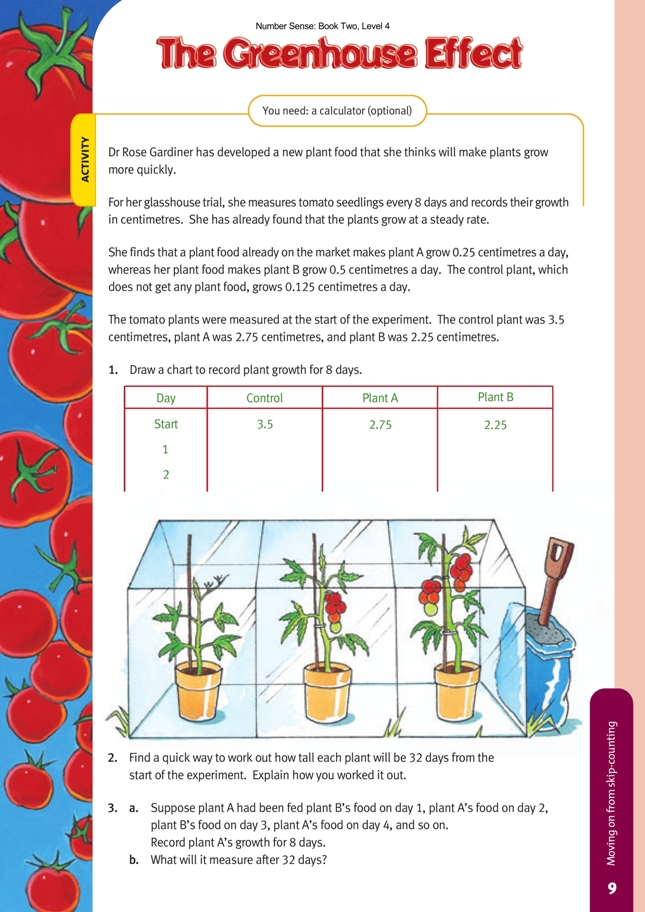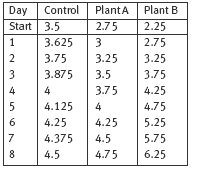This is a level 4 number activity from the Figure It Out series. It relates to Stage 7 of the Number Framework.
A PDF of the student activity is included.
Click on the image to enlarge it. Click again to close. Download PDF (582 KB)
solve problems that involve adding decimals
A calculator (optional)
The questions in this activity involve decimal numbers. To help the students to work with understanding, encourage them to look at the relationships between the rates of growth of the control plant, plant A, and plant B. The students could construct a chart setting out these relationships, maybe along the following lines:
The decimals 0.5, 0.25, and 0.125 are common decimals that the students will meet again and again, so an understanding of the fraction equivalents at this stage will stand them in good stead for later work. If time permits, some students may wish to draw up a chart of the decimal equivalents of three-eighths, five-eighths, and seven-eighths (assuming that they already know that two-eighths is one-quarter, four-eighths is one-half, and six-eighths is three-quarters).
When the students come to work out the 8-day growth for each of the plants in question 1, they are likely to find that the calculator is an invaluable aid. For example, for the control plant, they should key in the starting height and then + .125 = . This will obviously give the height at the end of day 1 (that is, 3.625). If they systematically press = on the calculator, they can then get the height for each succeeding day, namely 3.75, 3.875, and so on. The students can follow the same procedure for plant A and plant B, except that it will be necessary to add .25 and .5 respectively to the starting heights.
Question 2 challenges the students to think about how relationships between numbers can be used to figure out solutions to problems. Different strategies are possible, one of which is indicated in the Answers. Another is to simply use the calculator to multiply the daily growth of each plant by 32 and add on the starting height.
For instance, for the control plant, 32 x .125 + 3.5 = gives 7.5 centimetres. This equation can be adapted to fit any number of days’ growth, for any of the plants, by substituting the appropriate values for number of days, daily growth, and starting height respectively.
With question 3b, different strategies are also possible. The students may see that under the new plant-food regime, plant A will grow 0.75 centimetres in 2 days or 1.5 centimetres in 4 days. It is then a matter of either multiplying the 0.75 by 16 (16 lots of 2 days is 32 days) on a calculator or multiplying the 1.5 centimetres by 8 (eight lots of 4 days is 32 days) and then adding the starting height of 2.75 centimetres. Either way, the result will be 12 + 2.75, which is 14.75 centimetres.
Answers to Activity
1.
2. Day 32: control plant: 7.5; plant A: 10.75; plant B: 18.25. Explanations will vary. For example, plant B grew 4 cm in 8 days, so in 32 days it would grow 16 cm: 2.25 + 16 is 18.25.
3. a. Start at 2.75 cm: 3.25, 3.5, 4, 4.25, 4.75, 5, 5.5, 5.75.
b. 14.75 cm. The plant grows 0.75 cm every 2 days (0.75 x 16 = 12) or 1.5 cm every 4 days (1.5 x 8 = 12). 2.75 + 12 = 14.75


